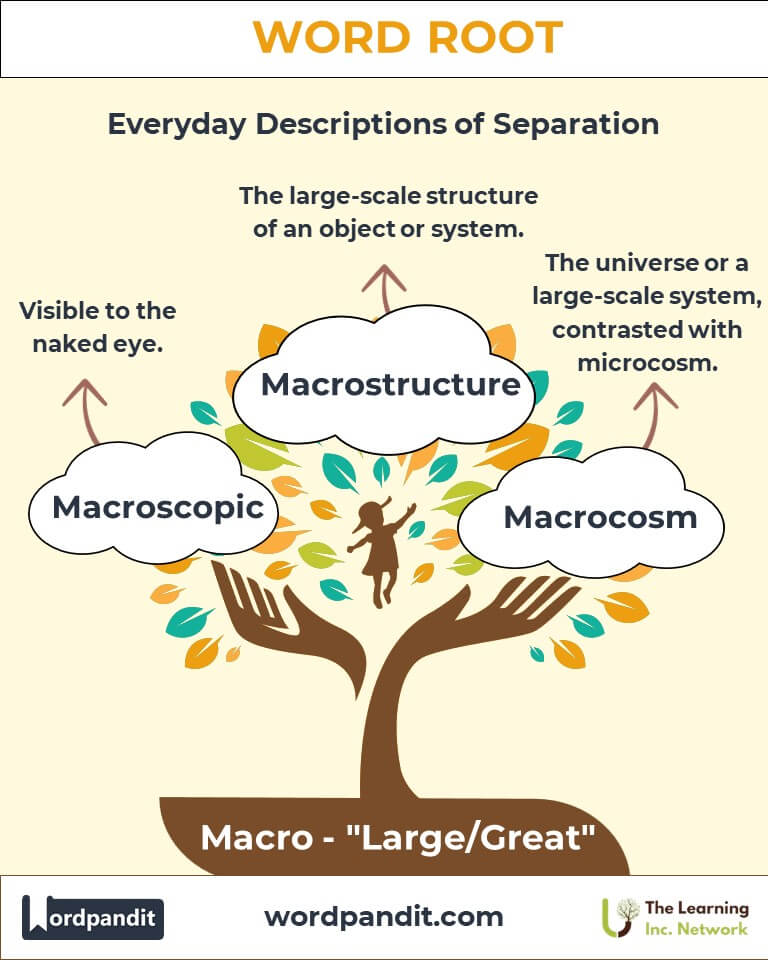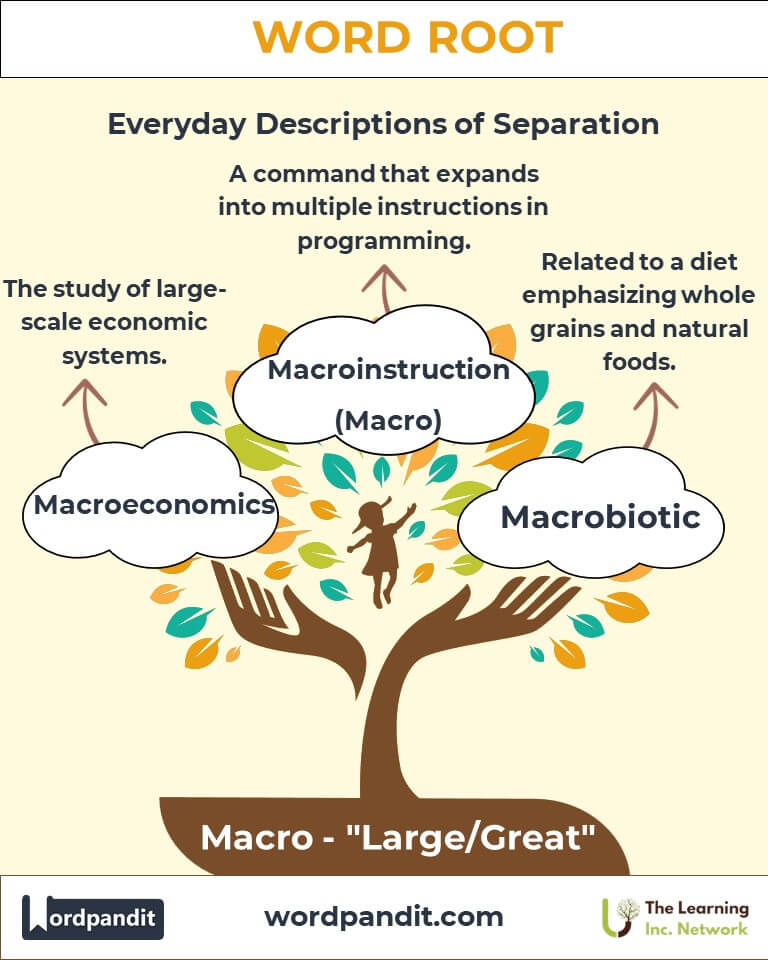Macro: Exploring the Big Picture in Language and Knowledge
Dive into the world of "Macro," a root that signifies "large" or "great." Derived from Greek, this root forms the backbone of terms like "macroscopic" and "macroeconomics," reflecting its significance in science, economics, and beyond. Let’s explore how "Macro" shapes our understanding of the vast and the grand.
Table of Contents
- Introduction: The Essence of Macro
- Etymology and Historical Journey
- Mnemonic: Unlocking the Power of Macro
- Common Macro-Related Terms
- Macro Through Time
- Macro in Specialized Fields
- Illustrative Story: Macro in Action
- Cultural Significance of the Macro Root
- The Macro Family Tree
- FAQs About the agr Word Root
- Test Your Knowledge: agr Word Root Quiz
- Conclusion: The Living Legacy of Macro
Introduction: The Essence of Macro
Think big, think "Macro." Pronounced MAK-roh, this root from the Greek word "makros" (meaning "large" or "long") is found in words that describe vastness or overarching perspectives. Whether we examine the "macroscopic" scale in science or "macroeconomics" in financial systems, Macro invites us to think beyond the minute details and grasp the broader picture.

Etymology and Historical Journey
The root "Macro" originates from the Greek word makros, meaning "long" or "large." It entered the English lexicon through scientific and philosophical texts during the Enlightenment era. Over time, "Macro" became synonymous with studying grand structures and overarching phenomena, especially in fields like biology, technology, and economics.
Mnemonic: Unlocking the Power of Macro
To remember "Macro," envision a magnifying glass over a sprawling cityscape, revealing its entirety rather than minute details.
Mnemonic Device: “Macro = Magnify the grand, overlook the small.”
Common Macro-Related Terms
- Macroscopic (mak-ruh-SKOP-ik): Visible to the naked eye.
Example: "While viruses are microscopic, tree leaves are macroscopic."
- Macroeconomics (mak-roh-ek-uh-NOM-iks): The study of large-scale economic systems.
Example: "Macroeconomics examines factors like national income and inflation."
- Macrostructure (mak-roh-STRUK-chur): The large-scale structure of an object or system.
Example: "The macrostructure of the bridge was designed to endure strong winds."
- Macrocosm (MAK-roh-kozm): The universe or a large-scale system, contrasted with microcosm.
Example: "Astrologers often explore the macrocosm to understand humanity’s place in it."
- Macrobiotic (mak-roh-bye-OT-ik): Related to a diet emphasizing whole grains and natural foods.
Example: "She follows a macrobiotic diet to maintain a healthy lifestyle."
Macro Through Time
- Macrocosm:
In ancient philosophy, the macrocosm symbolized the universe, while the microcosm reflected individual beings.
- Macroscopic:
Coined during the 19th century, it described objects large enough to be seen without a microscope.
Macro in Specialized Fields
- Science:
Macroscopic: Used in biology and physics to study observable phenomena.
Example: "Observing macroscopic changes in cell culture indicates bacterial growth."
- Economics:
Macroeconomics: Analyzing national and global economies.
Example: "Policymakers rely on macroeconomic models to predict recession trends."
- Technology:
Macroinstruction (Macro): A single command in programming that expands into multiple instructions.
Example: "Macros simplify repetitive tasks in software like Excel."
Illustrative Story: Macro in Action
Dr. Elena, a renowned economist, faced the challenge of explaining economic disparities to her students. She used a macroeconomic model showing global wealth distribution. Simultaneously, a physicist in another lecture hall demonstrated macroscopic energy patterns in the universe. Though their fields were different, their shared use of "Macro" reflected the importance of understanding the bigger picture in solving complex issues.
Cultural Significance of the Macro Root
From philosophical debates about the "macrocosm" to modern macroeconomic policies, "Macro" symbolizes our quest to comprehend vast systems. It urges us to think holistically—whether addressing societal challenges or marveling at the universe’s grandeur.

The Macro Family Tree
- Micro (small):
- Microscopic: Too small to be seen without a microscope.
Example: "Microscopic particles can cause allergic reactions."
- Mega (great):
- Megaphone: A device to amplify sound.
Example: "She used a megaphone to rally the crowd."
- Max (greatest):
- Maximum: The highest or greatest amount.
Example: "The car reached its maximum speed on the highway."

FAQs About the "Macro" Word Root
Q: What does "Macro" mean?
A: "Macro" means "large" or "great." It originates from the Greek word makros. This root is often used to describe things that are large in scale, visible to the naked eye, or comprehensive in nature, such as "macroscopic" (large enough to be seen) or "macroeconomics" (study of large-scale economic systems).
Q: How does "Macro" differ from "Micro"?
A: While "Macro" refers to the large, broad, or overarching, "Micro" pertains to the small, detailed, or minute. For instance, "macroscopic" deals with objects visible to the naked eye, whereas "microscopic" focuses on objects that require a microscope to be seen. Together, they represent complementary perspectives in science and analysis.
Q: What does "Macroeconomics" study?
A: Macroeconomics examines large-scale economic factors such as national income, inflation, unemployment, and economic growth. Unlike "microeconomics," which focuses on individual or business-level decisions, macroeconomics looks at broader trends that impact entire countries or regions. For example, it might analyze how government policies influence a nation's GDP.
Q: What is the difference between "Macrostructure" and "Microstructure"?
A: "Macrostructure" refers to the large-scale structure or overarching framework of an object or system, such as the design of a bridge. In contrast, "microstructure" focuses on the fine details and composition, such as the arrangement of particles in a metal alloy.
Q: What is a "Macro" in technology?
A: In technology, a "Macro" is a single command or instruction that expands into multiple commands or tasks. It automates repetitive actions in software, like Excel, where a macro might format data or generate a report with one click. This saves time and ensures consistency in processes.
Q: Why is "Macro" important in science?
A: In science, "Macro" helps describe phenomena on a large scale that can be observed without special tools. For example, macroscopic studies in biology might analyze the behavior of animals, while microscopic studies focus on cells. This root allows scientists to distinguish between broad and detailed perspectives.
Q: What does "Macrobiotic" mean?
A: "Macrobiotic" refers to a lifestyle or diet that emphasizes natural, whole foods believed to promote health and longevity. Rooted in Greek origins, it combines "macro" (large or long) with "bios" (life) to signify "long life" or holistic well-being.
Test Your Knowledge: Macro Word Root Quiz
1. What does "Macro" mean?
2. Which word describes objects visible to the naked eye?
3. What does Macroeconomics study?
4. Which prefix contrasts with "Macro"?
5. What is a Macro in technology?
Conclusion: The Living Legacy of Macro
The "Macro" root continues to inspire explorations of the vast and the significant, from cosmic mysteries to global economies. Its presence in our vocabulary reflects a universal desire to grasp the grander scale of existence. By embracing "Macro," we step back and see the full picture—an invaluable perspective in an ever-complex world.













A nice site to learn English